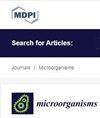冷藏贮藏期间白芸豆提取物和牛奶混合物发酵饮料的理化、感官和微生物分析
IF 4.1
2区 生物学
Q2 MICROBIOLOGY
引用次数: 0
摘要
由于白芸豆提取物对膳食的影响较小,且含有生物活性化合物(如多酚和类黄酮),因此是一种极具吸引力的发酵饮料原料。它既可单独使用,也可与牛奶混合使用,为帮助满足奶制品在季节中期短缺时的需求提供了一种有前景的解决方案。因此,本研究旨在探讨白芸豆提取物、牛奶及其混合物制成的类乳发酵饮料在 4 ℃ 下贮存 28 天期间的理化特征、感官特性和微生物概况。用不同比例的牛奶(CM)和芸豆提取物(BE)制备了三种混合发酵乳饮料(FMLDs):FMLD1(CM 30%:BE 70%)、FMLD2(CM 50%:BE 50%)、FMLD3(CM 70%:BE 30%),以及纯发酵芸豆提取物(FBE;CM 0%:BE 100%)和纯发酵牛奶(FCM;CM 100%:BE 0%)。混合物在 92 °C 下巴氏灭菌 25 分钟,然后在 43 °C 下用益生菌型启动培养物(嗜热杆菌、双歧杆菌、嗜酸乳杆菌)发酵。与发酵牛乳和混合乳相比,FBE 的碳水化合物(2.14%)、脂肪(0.11%)和蛋白质(1.45%)含量最低。豆提取物比例较高的 FBE 和发酵混合物的粘度和乳酸含量较低,色泽较绿,回味和异味较明显,总体可接受性得分较低。虽然 FCM 的嗜热菌和嗜酸乳杆菌数量较高,但 FBE 的双歧杆菌数量明显较高。这项研究表明,使用白芸豆提取物及其与牛奶的混合物可以制作出独特的发酵产品,而且对膳食的影响较小,同时强调了进一步优化配方的重要性,以提高感官质量并减少添加了芸豆提取物的产品中的豆腥味。本文章由计算机程序翻译,如有差异,请以英文原文为准。
Physicochemical, Sensory, and Microbiological Analysis of Fermented Drinks Made from White Kidney Bean Extract and Cow’s Milk Blends during Refrigerated Storage
Due to its low dietary impact and bioactive compounds, such as polyphenols and flavonoids, white kidney bean extract is an attractive raw material for fermented drinks. It can be utilized either on its own or blended with cow’s milk, offering a promising solution to help meet dairy product demand during mid-season shortages. Therefore, this study aimed to explore the physicochemical characteristics, sensory properties, and microbiological profile of fermented milk-like drinks made from white kidney bean extract, cow’s milk and their blends during 28 days of storage at 4 °C. Three blends of fermented milk-like drinks (FMLDs) were prepared from different ratios of cow’s milk (CM) and kidney bean extract (BE): FMLD1 (CM 30%:BE 70%); FMLD2 (CM 50%:BE 50%), FMLD3 (CM 70%:BE 30%), along with plain fermented kidney been extract (FBE; CM 0%:BE 100%), and plain fermented cow’s milk (FCM; CM 100%:BE 0%). The mixtures were pasteurized at 92 °C for 25 min and fermented with a probiotic-type starter culture (S. thermophilus, B. bifidum, L. acidophilus) at 43 °C. FBE exhibited the lowest levels of carbohydrates (2.14%), fat (0.11%), and protein (1.45%) compared to fermented cow’s milk and blends. The FBE and the fermented blends with a higher ratio of bean extract had lower viscosity and lactic acid contents, greener hue, more pronounced aftertaste and off-flavors, and received lower overall acceptability scores. Although the FCM had higher counts of S. thermophilus and L. acidophilus, the FBE displayed significantly higher counts of B. bifidum. This study demonstrated the potential of using white kidney bean extract and its blends with cow’s milk to create unique fermented products with a lower dietary impact, highlighting the importance of further optimizing the formulations to enhance sensory qualities and reduce the beany off-flavors in the products with added kidney bean extract.
求助全文
通过发布文献求助,成功后即可免费获取论文全文。
去求助
来源期刊

Microorganisms
Medicine-Microbiology (medical)
CiteScore
7.40
自引率
6.70%
发文量
2168
审稿时长
20.03 days
期刊介绍:
Microorganisms (ISSN 2076-2607) is an international, peer-reviewed open access journal which provides an advanced forum for studies related to prokaryotic and eukaryotic microorganisms, viruses and prions. It publishes reviews, research papers and communications. Our aim is to encourage scientists to publish their experimental and theoretical results in as much detail as possible. There is no restriction on the length of the papers. The full experimental details must be provided so that the results can be reproduced. Electronic files and software regarding the full details of the calculation or experimental procedure, if unable to be published in a normal way, can be deposited as supplementary electronic material.
 求助内容:
求助内容: 应助结果提醒方式:
应助结果提醒方式:


